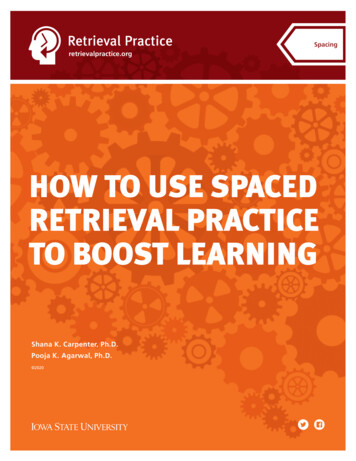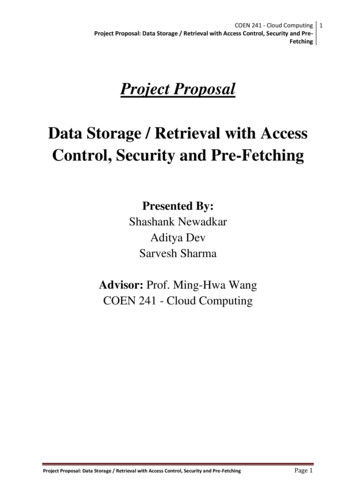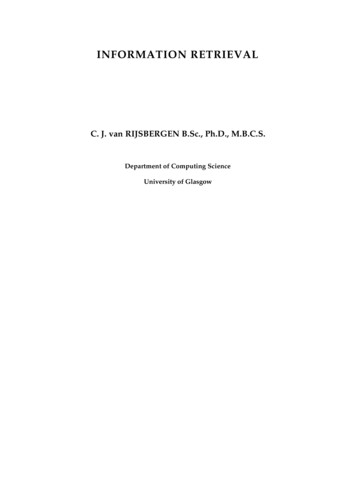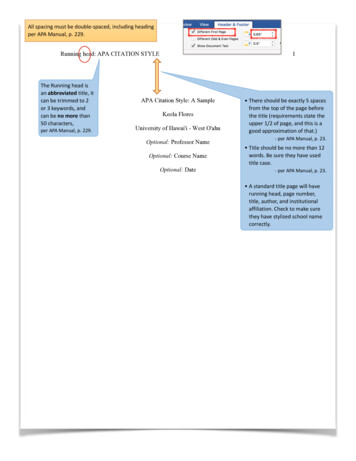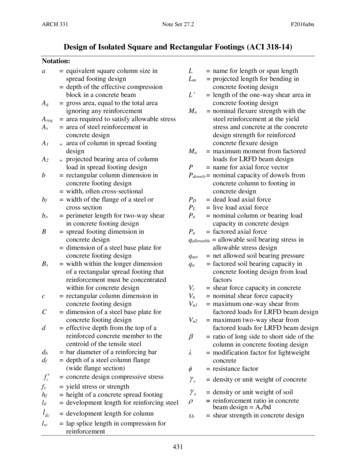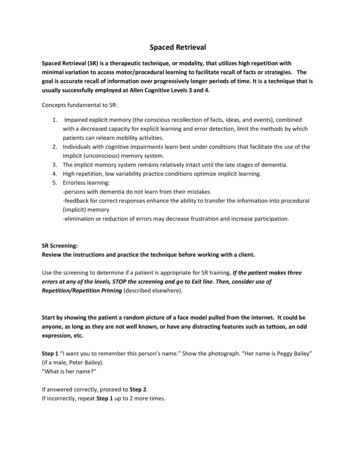
Transcription
Spaced RetrievalSpaced Retrieval (SR) is a therapeutic technique, or modality, that utilizes high repetition withminimal variation to access motor/procedural learning to facilitate recall of facts or strategies. Thegoal is accurate recall of information over progressively longer periods of time. It is a technique that isusually successfully employed at Allen Cognitive Levels 3 and 4.Concepts fundamental to SR:1.2.3.4.5.Impaired explicit memory (the conscious recollection of facts, ideas, and events), combinedwith a decreased capacity for explicit learning and error detection, limit the methods by whichpatients can relearn mobility activities.Individuals with cognitive impairments learn best under conditions that facilitate the use of theimplicit (unconscious) memory system.The implicit memory system remains relatively intact until the late stages of dementia.High repetition, low variability practice conditions optimize implicit learning.Errorless learning:-persons with dementia do not learn from their mistakes-feedback for correct responses enhance the ability to transfer the information into procedural(implicit) memory-elimination or reduction of errors may decrease frustration and increase participation.SR Screening:Review the instructions and practice the technique before working with a client.Use the screening to determine if a patient is appropriate for SR training. If the patient makes threeerrors at any of the levels, STOP the screening and go to Exit line. Then, consider use ofRepetition/Repetition Priming (described elsewhere).Start by showing the patient a random picture of a face model pulled from the internet. It could beanyone, as long as they are not well known, or have any distracting features such as tattoos, an oddexpression, etc.Step 1 “I want you to remember this person’s name.” Show the photograph. “Her name is Peggy Bailey”(if a male, Peter Bailey).“What is her name?”If answered correctly, proceed to Step 2.If incorrectly, repeat Step 1 up to 2 more times.
Step 2: (Distract with another activity or conversation for 10 seconds). Let’s try again. What is hername?”If answered correctly, “That’s right. I am glad you remembered.” Proceed to Step 3.If answered incorrectly, “Actually, her name is Peggy Bailey.” Go back to Step 1 and proceed accordingto directions. Remember, If the patient makes three errors at any of the levels, STOP the screeningand go to Exit line. Then, consider use of Repetition/Repetition Priming (described elsewhere).Step 3: (Distract with another activity or conversation for 15-20 seconds). Then, “You are doing wellremembering her name for a longer period of time, and that’s the idea. What is her name?”If answered correctly, “That’s right. You are remembering for a longer period of time. You did a great jobremembering her name. We are going to continue practicing this later today.” If you have reached thislevel successfully, the patient is candidate for SR therapy.If answered incorrectly, “Actually, her name is Peggy Bailey. What is her name?”. Go back to Step 2 andproceed. Remember, If the patient makes three errors at any of the levels, STOP the screening and goto Exit line. Then, consider use of Repetition/Repetition Priming (described elsewhere).Exit line: “Thanks for trying so hard. Let’s work on something else now.”If the patient is not able to successfully perform Step 1,2, and 3 during this session, try again onanother day, and pair the photograph with the name written on an index card which is placed facedown in front of the patient. Instruct the patient to flip the card over whenever he/she is asked thename.Repeat Steps 1,2, and 3 with the motor cue. If the patient makes three errors at any of thelevels, STOP the screening and go to Exit line. Then, consider use of Repetition/Repetition Priming(described elsewhere).SR Implementation:If the patient passes the screening, the team should decide which task item should be targeted. Onlyone task should be targeted. Some examples:1. Remembering to wear 02.2. Remembering to lock WC brakes before standing up.3. Remembering to reach back for or push up from the arms of a chair, or feel the back of a chairbefore sitting.4. Remembering to step inside the walker to increase stride length.5. Remembering to use call button/emergency alert necklace.6. Compensatory swallowing techniques (remembering to take a sip of water between bites).Spaced Retrieval cont.
7. Voice training – speaking more intelligiblyAs noted earlier, high repetition, low variability practice conditions optimize learning. Once atask is targeted, one member of the team (usually the OT or ST) takes the lead by initiating thestructured training, complete with counts of successful reproduction. The team will assist indetermining the motor cue and expected response, and all members of the team reproduce thisprocedure exactly. The leader is responsible for performing the sessions that primarily targetthis task over the next 3 weeks. The other members of the team will reproduce the procedureonce or twice during their sessions, but the leader is responsible for the spaced retrieval trainingand documenting the time intervals at which the patient is successful. The family and othercaregivers are brought in only after the patient has demonstrated successful retrieval ofinformation in the first 2-3 weeks, in order to minimize variability of procedure and cueing.Whenever possible, pair a motor response with the verbal cueing and response. Referring backto the examples above, here are some examples of cueing/response dialogs:1.Remembering to wear 02.Cue: “What do you wear all of the time?”Response: (Hands to face) “My oxygen.”2.Remembering to lock WC brakes before standing up.Cue: “What do you do before you stand up?”Response: (Hands on brakes and pushing them into locked position): “I lock my brakes.”3.Remembering to reach back for or push up from the arms of a chair, or feel the back of achair before sitting.Cue: “What do you do before you sit down?”Response: (Hands reaching back for the WC): “I reach back for my chair” OR “I touchthe chair with the backs of my legs”.4. Remembering to step inside the walker to increase stride length.Cue: “What do you do when you move your walker forward?”Response: (Taking an adequate stride into WC): ”I step inside my walker.”5. Remembering to use call button/emergency alert necklace.Cue: “What do you do when you need help?”Response: (Pushing call button) “I push my button”.6. Compensatory swallowing techniques (remembering to take a sip of water between bites).Cue: “What do you do after you take a bite of food?”Response: (Reaching for glass) “I take a sip of water”.
7. Articulation – speaking more intelligiblyCue: “What should you do when you speak.”Response: (Speaking loudly) “I open my mouth”. (Over-exaggerating mouth opening).8. Finding their rooma. Cue: “What should you do when you are lost?”.b. Response: “I look at my card.” (With room number on card)9. To decrease repetitive questioninga. Cue, “When you want to know when your next meal is, what do you do?”b. Response: “I look at my card.” (With meal times on card)Spaced retrieval is based on the principles of motor learning – it will take 2-3 weeks to get theinformation into motor memory. The frequency of SR sessions should be 3x/week. Don’t giveup before trying for 2 weeks; by the same token if the patient is not getting it in 3 weeks, it islikely that they may not be capable of responding to SR. Repetition/repetition priming may bemore appropriate.SR Procedure:Target single behaviorScreenImplement taskIncrease intervals1 minute, 2 minutes, 4 minutes, 8 minutes, 16 minutes, 32 minutes.If unsuccessful, correct with “Actually, you )”, go back to the last interval patient wassuccessful, and begin interval there.Example:“Today we are going to practice remembering to lock your brakes before you stand.”(demonstrate)“What should you do before you stand?” (have them verbalize and demonstrate).Correct response – “That’s right. I’m glad that you remembered.”Incorrect response – “Actually, you should lock your brakes.”Correct response: Increase recall interval to 1 minute, then 2, then 4, then 8, then 16, then 32minutes. Intervals should be filled with conversation or therapeutic activities.Incorrect response – After obtaining immediate recall, go back to last successful interval andproceed from there.At the beginning of the next session, ask for recall, “What should you do before you stand?”
Correct response – no further training needed that sessionIf correct recall at the beginning of three sessions, they should have it and not need furthertraining.Continue to ask about the originally trained information at the beginning of each session.Spaced Retrieval TherAppy: iTunes app that provides an expanded interval timer to keep trackof the intervals and patient performance. 3.99; available for iPhone and iPad, and iPod touch.References:Brush J, and Camp C. A Therapy Technique for Improving Memory: Spaced Retrieval. MenorahPark Center for Senior Living, 27100 Cedar Road, Beachwood, OH. This publication containsreproducible sheets that can be used to keep track of the patient’s responses.White L, Ford M, Brown M, Peel C, Triebel K. Case Report: Facilitating the use of implicitmemory and learning in the physical therapy management of individuals with AlzheimerDisease: A Case Series. Journal of Geriatric Physical Therapy. 2014;37(1): 35-44.
Some examples: 1. Remembering to wear 02. 2. Remembering to lock WC brakes before standing up. 3. Remembering to reach back for or push up from the arms of a chair, or feel the back of a chair before sitting. 4. Remembering to step inside the walker to increase stride length. 5. Remembering to use call button/emergency alert necklace. 6.


